Marketing Principles Report: Analysis of The Cambridge Satchel Company
VerifiedAdded on 2019/12/03
|13
|4105
|151
Report
AI Summary
This report provides a comprehensive analysis of the marketing principles applied to The Cambridge Satchel Company, a UK-based producer of satchels and leather goods. It begins by outlining the elements of the marketing process, including understanding customer needs, designing a customer-driven marketing strategy, constructing an integrated marketing program, building customer relationships, and capturing customer value. The report then evaluates the benefits and costs of a marketing orientation, exploring the impact of market research and customer value. It also includes a stakeholder and PEST analysis to understand the micro and macro environments. Segmentation, targeting, and positioning strategies are proposed for the company's laptop bag product. The impact of buyer behavior on marketing activities is examined, and strategies for sustaining competitive advantage, distribution arrangements, and pricing are discussed. Finally, the report recommends marketing mixes for different market segments and develops a marketing plan, differentiating between B2B and B2C approaches and considering international marketing implications.
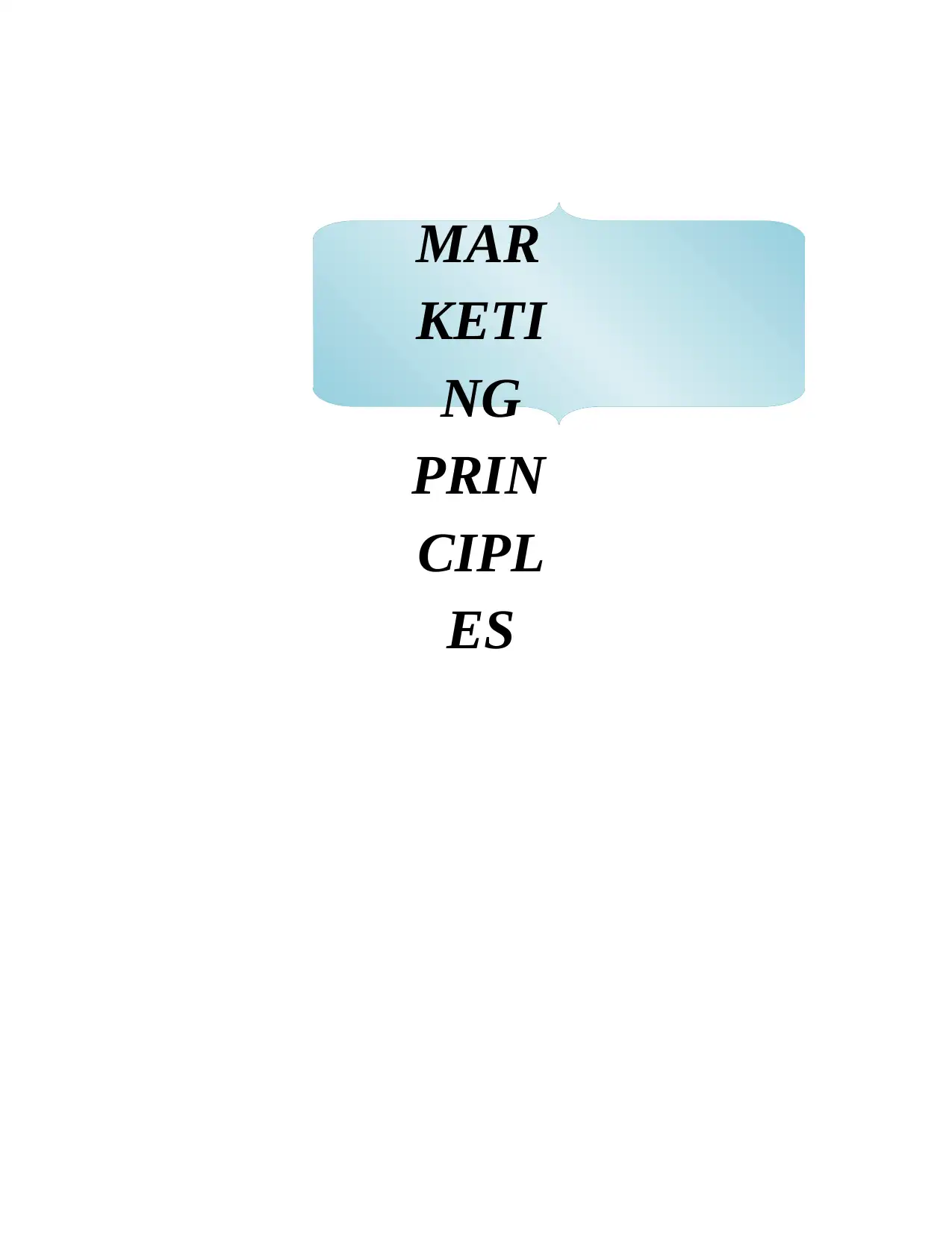
MAR
KETI
NG
PRIN
CIPL
ES
KETI
NG
PRIN
CIPL
ES
Paraphrase This Document
Need a fresh take? Get an instant paraphrase of this document with our AI Paraphraser
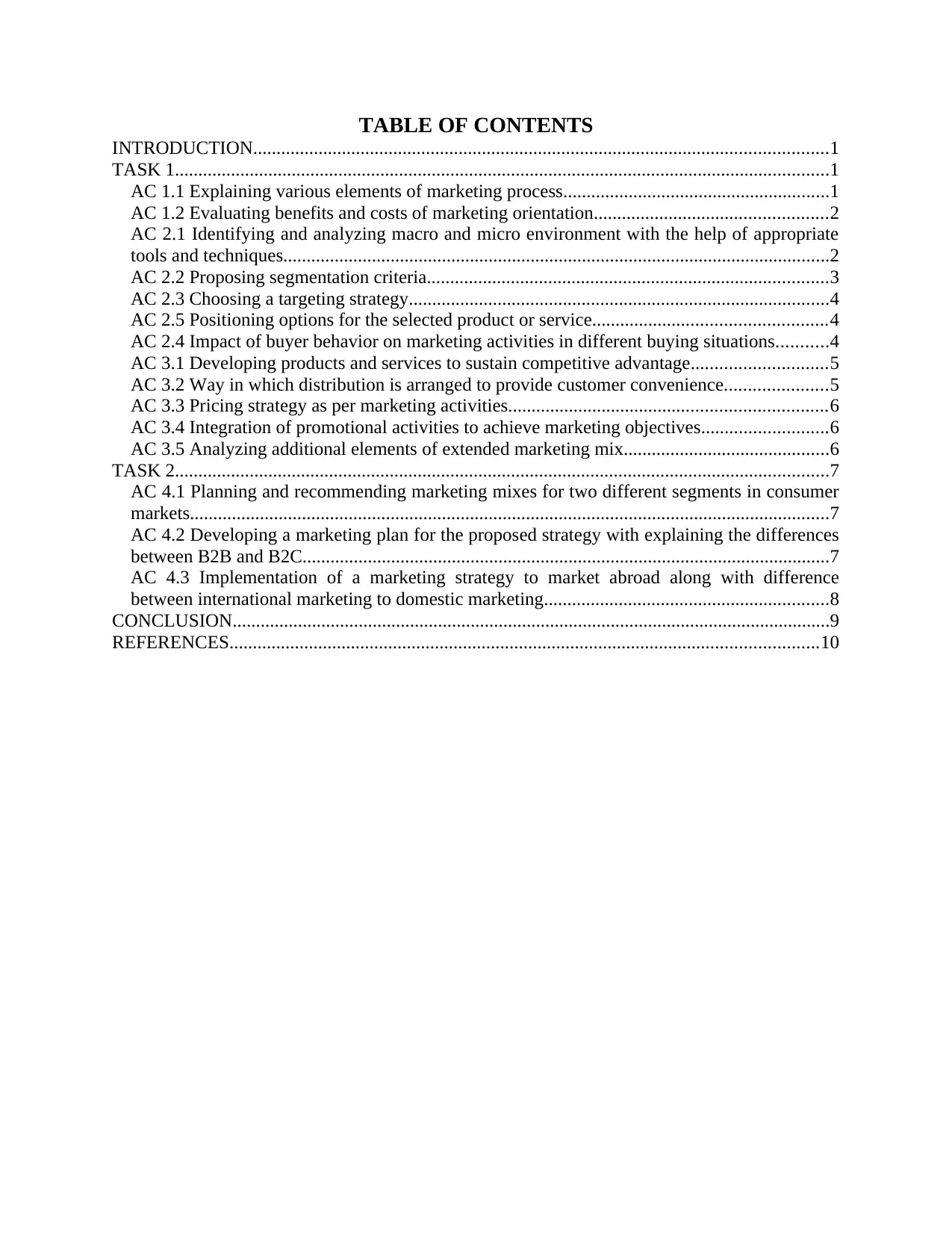
TABLE OF CONTENTS
INTRODUCTION...........................................................................................................................1
TASK 1............................................................................................................................................1
AC 1.1 Explaining various elements of marketing process.........................................................1
AC 1.2 Evaluating benefits and costs of marketing orientation..................................................2
AC 2.1 Identifying and analyzing macro and micro environment with the help of appropriate
tools and techniques.....................................................................................................................2
AC 2.2 Proposing segmentation criteria......................................................................................3
AC 2.3 Choosing a targeting strategy..........................................................................................4
AC 2.5 Positioning options for the selected product or service..................................................4
AC 2.4 Impact of buyer behavior on marketing activities in different buying situations...........4
AC 3.1 Developing products and services to sustain competitive advantage.............................5
AC 3.2 Way in which distribution is arranged to provide customer convenience......................5
AC 3.3 Pricing strategy as per marketing activities....................................................................6
AC 3.4 Integration of promotional activities to achieve marketing objectives...........................6
AC 3.5 Analyzing additional elements of extended marketing mix............................................6
TASK 2............................................................................................................................................7
AC 4.1 Planning and recommending marketing mixes for two different segments in consumer
markets.........................................................................................................................................7
AC 4.2 Developing a marketing plan for the proposed strategy with explaining the differences
between B2B and B2C.................................................................................................................7
AC 4.3 Implementation of a marketing strategy to market abroad along with difference
between international marketing to domestic marketing.............................................................8
CONCLUSION................................................................................................................................9
REFERENCES..............................................................................................................................10
INTRODUCTION...........................................................................................................................1
TASK 1............................................................................................................................................1
AC 1.1 Explaining various elements of marketing process.........................................................1
AC 1.2 Evaluating benefits and costs of marketing orientation..................................................2
AC 2.1 Identifying and analyzing macro and micro environment with the help of appropriate
tools and techniques.....................................................................................................................2
AC 2.2 Proposing segmentation criteria......................................................................................3
AC 2.3 Choosing a targeting strategy..........................................................................................4
AC 2.5 Positioning options for the selected product or service..................................................4
AC 2.4 Impact of buyer behavior on marketing activities in different buying situations...........4
AC 3.1 Developing products and services to sustain competitive advantage.............................5
AC 3.2 Way in which distribution is arranged to provide customer convenience......................5
AC 3.3 Pricing strategy as per marketing activities....................................................................6
AC 3.4 Integration of promotional activities to achieve marketing objectives...........................6
AC 3.5 Analyzing additional elements of extended marketing mix............................................6
TASK 2............................................................................................................................................7
AC 4.1 Planning and recommending marketing mixes for two different segments in consumer
markets.........................................................................................................................................7
AC 4.2 Developing a marketing plan for the proposed strategy with explaining the differences
between B2B and B2C.................................................................................................................7
AC 4.3 Implementation of a marketing strategy to market abroad along with difference
between international marketing to domestic marketing.............................................................8
CONCLUSION................................................................................................................................9
REFERENCES..............................................................................................................................10
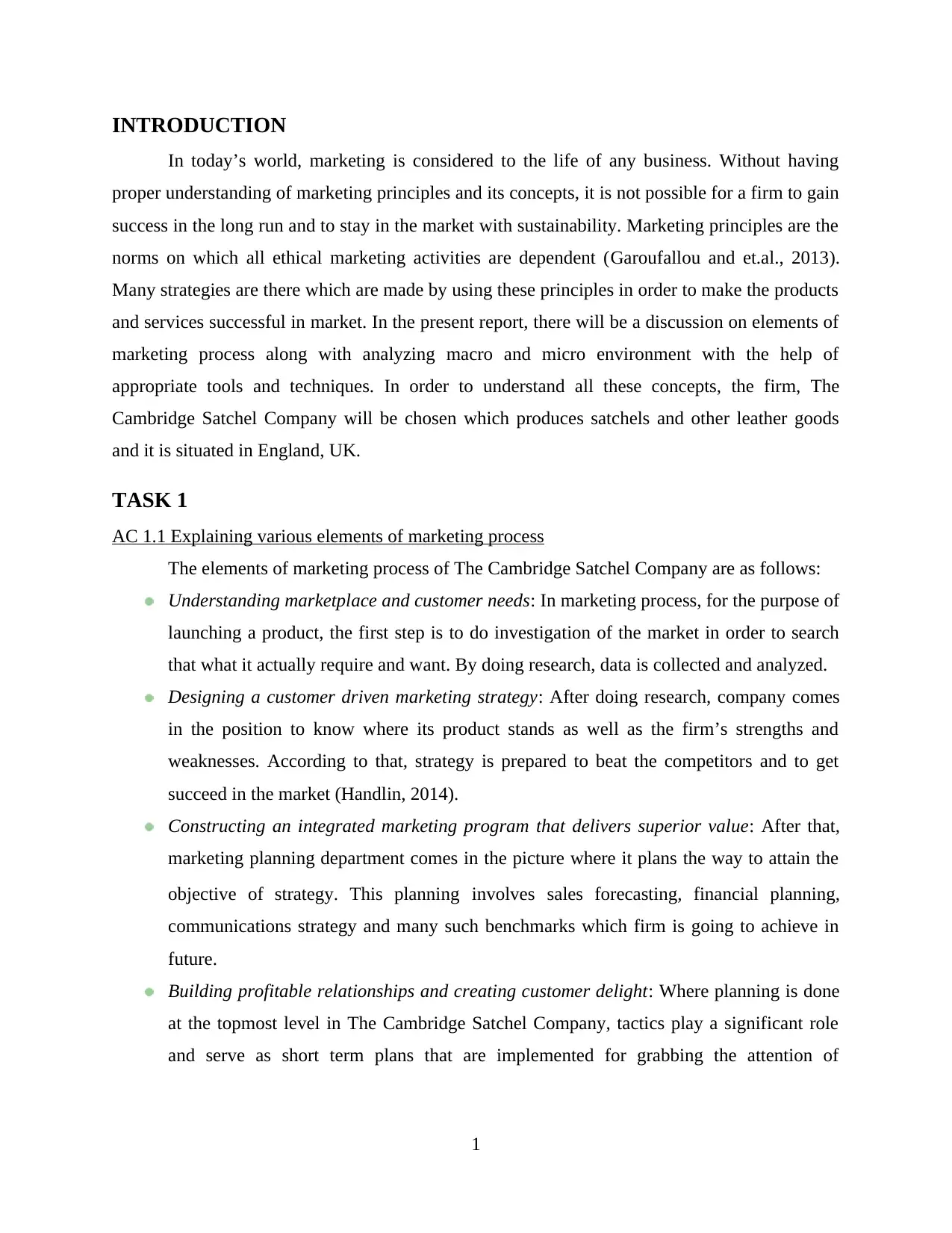
INTRODUCTION
In today’s world, marketing is considered to the life of any business. Without having
proper understanding of marketing principles and its concepts, it is not possible for a firm to gain
success in the long run and to stay in the market with sustainability. Marketing principles are the
norms on which all ethical marketing activities are dependent (Garoufallou and et.al., 2013).
Many strategies are there which are made by using these principles in order to make the products
and services successful in market. In the present report, there will be a discussion on elements of
marketing process along with analyzing macro and micro environment with the help of
appropriate tools and techniques. In order to understand all these concepts, the firm, The
Cambridge Satchel Company will be chosen which produces satchels and other leather goods
and it is situated in England, UK.
TASK 1
AC 1.1 Explaining various elements of marketing process
The elements of marketing process of The Cambridge Satchel Company are as follows:
Understanding marketplace and customer needs: In marketing process, for the purpose of
launching a product, the first step is to do investigation of the market in order to search
that what it actually require and want. By doing research, data is collected and analyzed.
Designing a customer driven marketing strategy: After doing research, company comes
in the position to know where its product stands as well as the firm’s strengths and
weaknesses. According to that, strategy is prepared to beat the competitors and to get
succeed in the market (Handlin, 2014).
Constructing an integrated marketing program that delivers superior value: After that,
marketing planning department comes in the picture where it plans the way to attain the
objective of strategy. This planning involves sales forecasting, financial planning,
communications strategy and many such benchmarks which firm is going to achieve in
future.
Building profitable relationships and creating customer delight: Where planning is done
at the topmost level in The Cambridge Satchel Company, tactics play a significant role
and serve as short term plans that are implemented for grabbing the attention of
1
In today’s world, marketing is considered to the life of any business. Without having
proper understanding of marketing principles and its concepts, it is not possible for a firm to gain
success in the long run and to stay in the market with sustainability. Marketing principles are the
norms on which all ethical marketing activities are dependent (Garoufallou and et.al., 2013).
Many strategies are there which are made by using these principles in order to make the products
and services successful in market. In the present report, there will be a discussion on elements of
marketing process along with analyzing macro and micro environment with the help of
appropriate tools and techniques. In order to understand all these concepts, the firm, The
Cambridge Satchel Company will be chosen which produces satchels and other leather goods
and it is situated in England, UK.
TASK 1
AC 1.1 Explaining various elements of marketing process
The elements of marketing process of The Cambridge Satchel Company are as follows:
Understanding marketplace and customer needs: In marketing process, for the purpose of
launching a product, the first step is to do investigation of the market in order to search
that what it actually require and want. By doing research, data is collected and analyzed.
Designing a customer driven marketing strategy: After doing research, company comes
in the position to know where its product stands as well as the firm’s strengths and
weaknesses. According to that, strategy is prepared to beat the competitors and to get
succeed in the market (Handlin, 2014).
Constructing an integrated marketing program that delivers superior value: After that,
marketing planning department comes in the picture where it plans the way to attain the
objective of strategy. This planning involves sales forecasting, financial planning,
communications strategy and many such benchmarks which firm is going to achieve in
future.
Building profitable relationships and creating customer delight: Where planning is done
at the topmost level in The Cambridge Satchel Company, tactics play a significant role
and serve as short term plans that are implemented for grabbing the attention of
1
⊘ This is a preview!⊘
Do you want full access?
Subscribe today to unlock all pages.

Trusted by 1+ million students worldwide
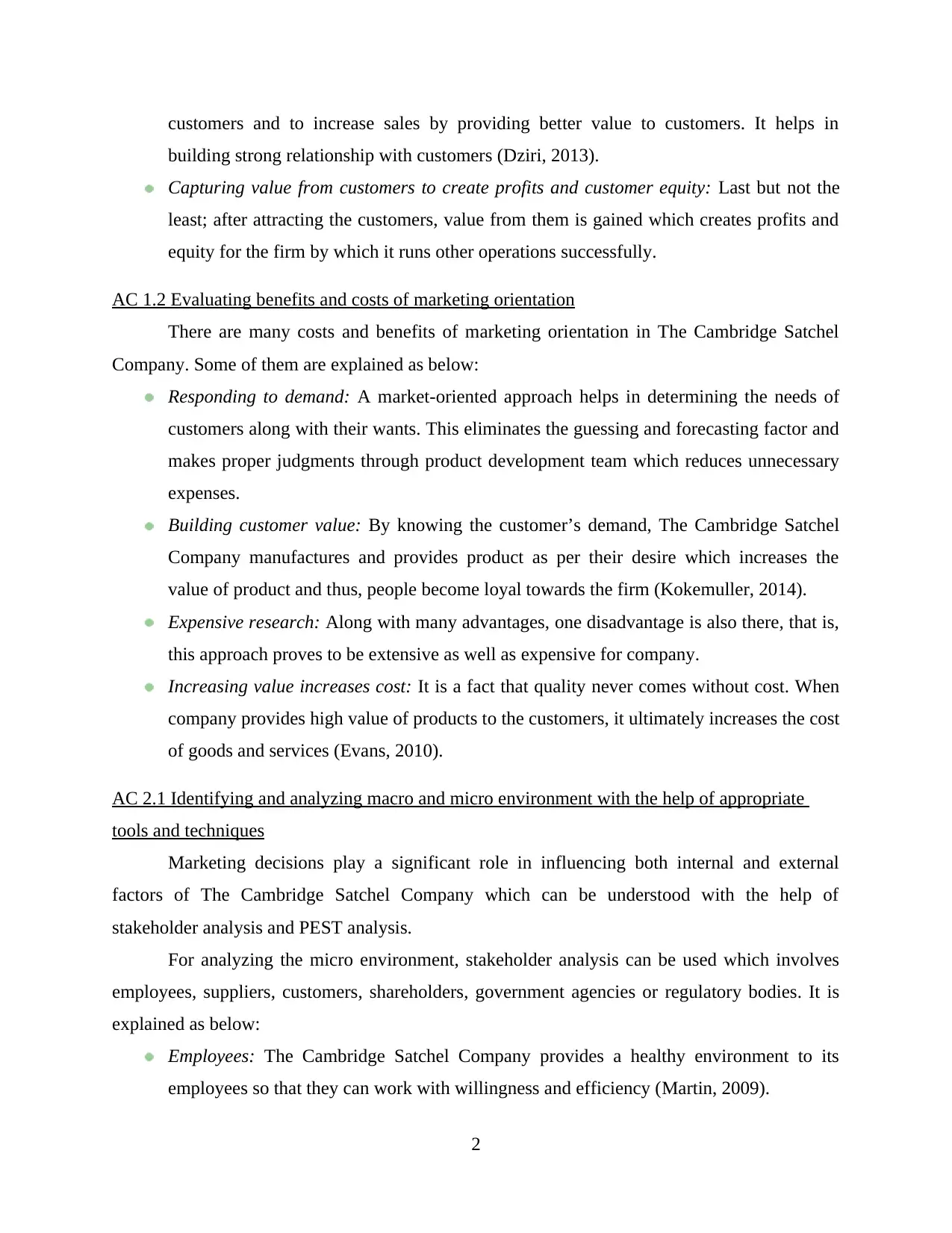
customers and to increase sales by providing better value to customers. It helps in
building strong relationship with customers (Dziri, 2013).
Capturing value from customers to create profits and customer equity: Last but not the
least; after attracting the customers, value from them is gained which creates profits and
equity for the firm by which it runs other operations successfully.
AC 1.2 Evaluating benefits and costs of marketing orientation
There are many costs and benefits of marketing orientation in The Cambridge Satchel
Company. Some of them are explained as below:
Responding to demand: A market-oriented approach helps in determining the needs of
customers along with their wants. This eliminates the guessing and forecasting factor and
makes proper judgments through product development team which reduces unnecessary
expenses.
Building customer value: By knowing the customer’s demand, The Cambridge Satchel
Company manufactures and provides product as per their desire which increases the
value of product and thus, people become loyal towards the firm (Kokemuller, 2014).
Expensive research: Along with many advantages, one disadvantage is also there, that is,
this approach proves to be extensive as well as expensive for company.
Increasing value increases cost: It is a fact that quality never comes without cost. When
company provides high value of products to the customers, it ultimately increases the cost
of goods and services (Evans, 2010).
AC 2.1 Identifying and analyzing macro and micro environment with the help of appropriate
tools and techniques
Marketing decisions play a significant role in influencing both internal and external
factors of The Cambridge Satchel Company which can be understood with the help of
stakeholder analysis and PEST analysis.
For analyzing the micro environment, stakeholder analysis can be used which involves
employees, suppliers, customers, shareholders, government agencies or regulatory bodies. It is
explained as below:
Employees: The Cambridge Satchel Company provides a healthy environment to its
employees so that they can work with willingness and efficiency (Martin, 2009).
2
building strong relationship with customers (Dziri, 2013).
Capturing value from customers to create profits and customer equity: Last but not the
least; after attracting the customers, value from them is gained which creates profits and
equity for the firm by which it runs other operations successfully.
AC 1.2 Evaluating benefits and costs of marketing orientation
There are many costs and benefits of marketing orientation in The Cambridge Satchel
Company. Some of them are explained as below:
Responding to demand: A market-oriented approach helps in determining the needs of
customers along with their wants. This eliminates the guessing and forecasting factor and
makes proper judgments through product development team which reduces unnecessary
expenses.
Building customer value: By knowing the customer’s demand, The Cambridge Satchel
Company manufactures and provides product as per their desire which increases the
value of product and thus, people become loyal towards the firm (Kokemuller, 2014).
Expensive research: Along with many advantages, one disadvantage is also there, that is,
this approach proves to be extensive as well as expensive for company.
Increasing value increases cost: It is a fact that quality never comes without cost. When
company provides high value of products to the customers, it ultimately increases the cost
of goods and services (Evans, 2010).
AC 2.1 Identifying and analyzing macro and micro environment with the help of appropriate
tools and techniques
Marketing decisions play a significant role in influencing both internal and external
factors of The Cambridge Satchel Company which can be understood with the help of
stakeholder analysis and PEST analysis.
For analyzing the micro environment, stakeholder analysis can be used which involves
employees, suppliers, customers, shareholders, government agencies or regulatory bodies. It is
explained as below:
Employees: The Cambridge Satchel Company provides a healthy environment to its
employees so that they can work with willingness and efficiency (Martin, 2009).
2
Paraphrase This Document
Need a fresh take? Get an instant paraphrase of this document with our AI Paraphraser
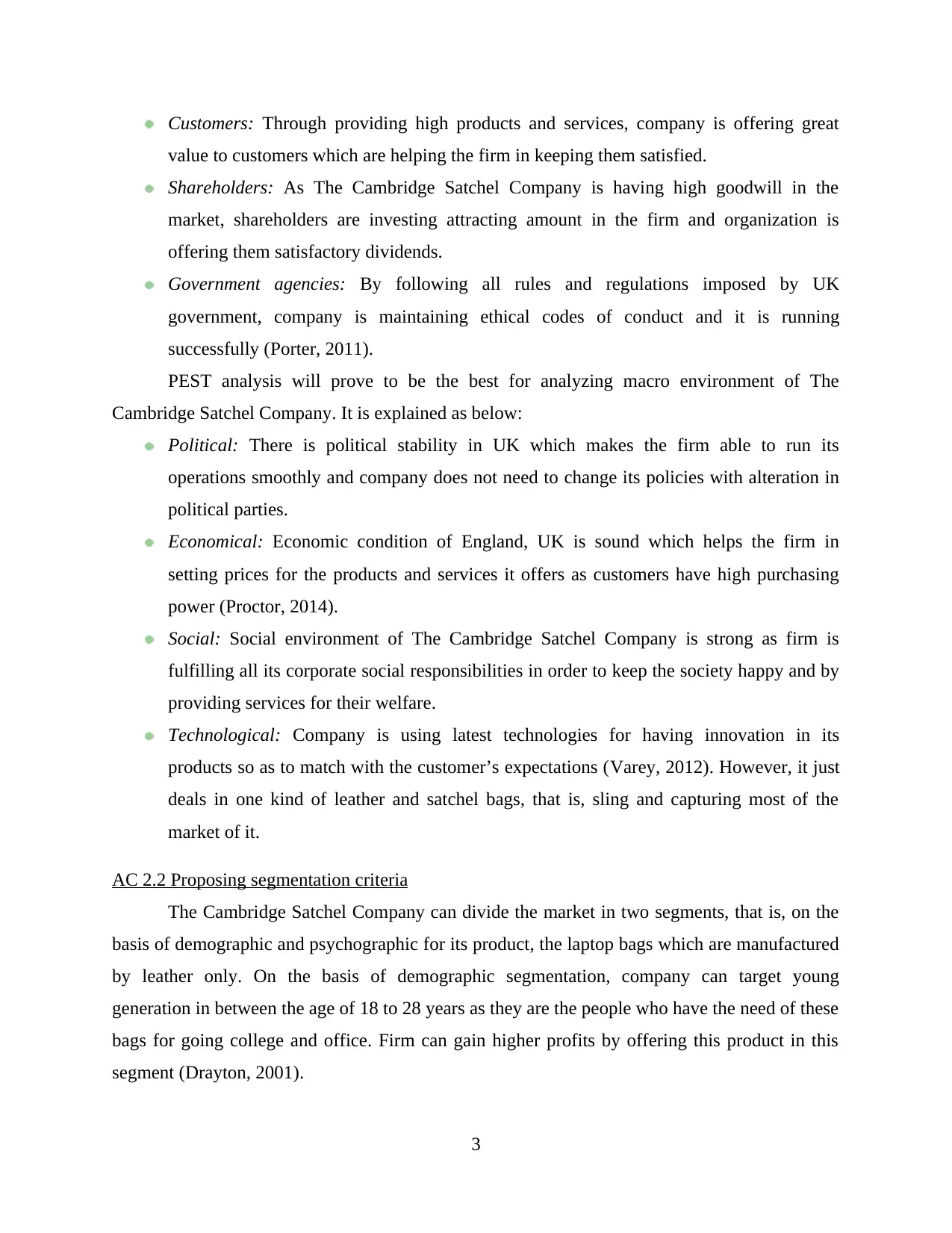
Customers: Through providing high products and services, company is offering great
value to customers which are helping the firm in keeping them satisfied.
Shareholders: As The Cambridge Satchel Company is having high goodwill in the
market, shareholders are investing attracting amount in the firm and organization is
offering them satisfactory dividends.
Government agencies: By following all rules and regulations imposed by UK
government, company is maintaining ethical codes of conduct and it is running
successfully (Porter, 2011).
PEST analysis will prove to be the best for analyzing macro environment of The
Cambridge Satchel Company. It is explained as below:
Political: There is political stability in UK which makes the firm able to run its
operations smoothly and company does not need to change its policies with alteration in
political parties.
Economical: Economic condition of England, UK is sound which helps the firm in
setting prices for the products and services it offers as customers have high purchasing
power (Proctor, 2014).
Social: Social environment of The Cambridge Satchel Company is strong as firm is
fulfilling all its corporate social responsibilities in order to keep the society happy and by
providing services for their welfare.
Technological: Company is using latest technologies for having innovation in its
products so as to match with the customer’s expectations (Varey, 2012). However, it just
deals in one kind of leather and satchel bags, that is, sling and capturing most of the
market of it.
AC 2.2 Proposing segmentation criteria
The Cambridge Satchel Company can divide the market in two segments, that is, on the
basis of demographic and psychographic for its product, the laptop bags which are manufactured
by leather only. On the basis of demographic segmentation, company can target young
generation in between the age of 18 to 28 years as they are the people who have the need of these
bags for going college and office. Firm can gain higher profits by offering this product in this
segment (Drayton, 2001).
3
value to customers which are helping the firm in keeping them satisfied.
Shareholders: As The Cambridge Satchel Company is having high goodwill in the
market, shareholders are investing attracting amount in the firm and organization is
offering them satisfactory dividends.
Government agencies: By following all rules and regulations imposed by UK
government, company is maintaining ethical codes of conduct and it is running
successfully (Porter, 2011).
PEST analysis will prove to be the best for analyzing macro environment of The
Cambridge Satchel Company. It is explained as below:
Political: There is political stability in UK which makes the firm able to run its
operations smoothly and company does not need to change its policies with alteration in
political parties.
Economical: Economic condition of England, UK is sound which helps the firm in
setting prices for the products and services it offers as customers have high purchasing
power (Proctor, 2014).
Social: Social environment of The Cambridge Satchel Company is strong as firm is
fulfilling all its corporate social responsibilities in order to keep the society happy and by
providing services for their welfare.
Technological: Company is using latest technologies for having innovation in its
products so as to match with the customer’s expectations (Varey, 2012). However, it just
deals in one kind of leather and satchel bags, that is, sling and capturing most of the
market of it.
AC 2.2 Proposing segmentation criteria
The Cambridge Satchel Company can divide the market in two segments, that is, on the
basis of demographic and psychographic for its product, the laptop bags which are manufactured
by leather only. On the basis of demographic segmentation, company can target young
generation in between the age of 18 to 28 years as they are the people who have the need of these
bags for going college and office. Firm can gain higher profits by offering this product in this
segment (Drayton, 2001).
3
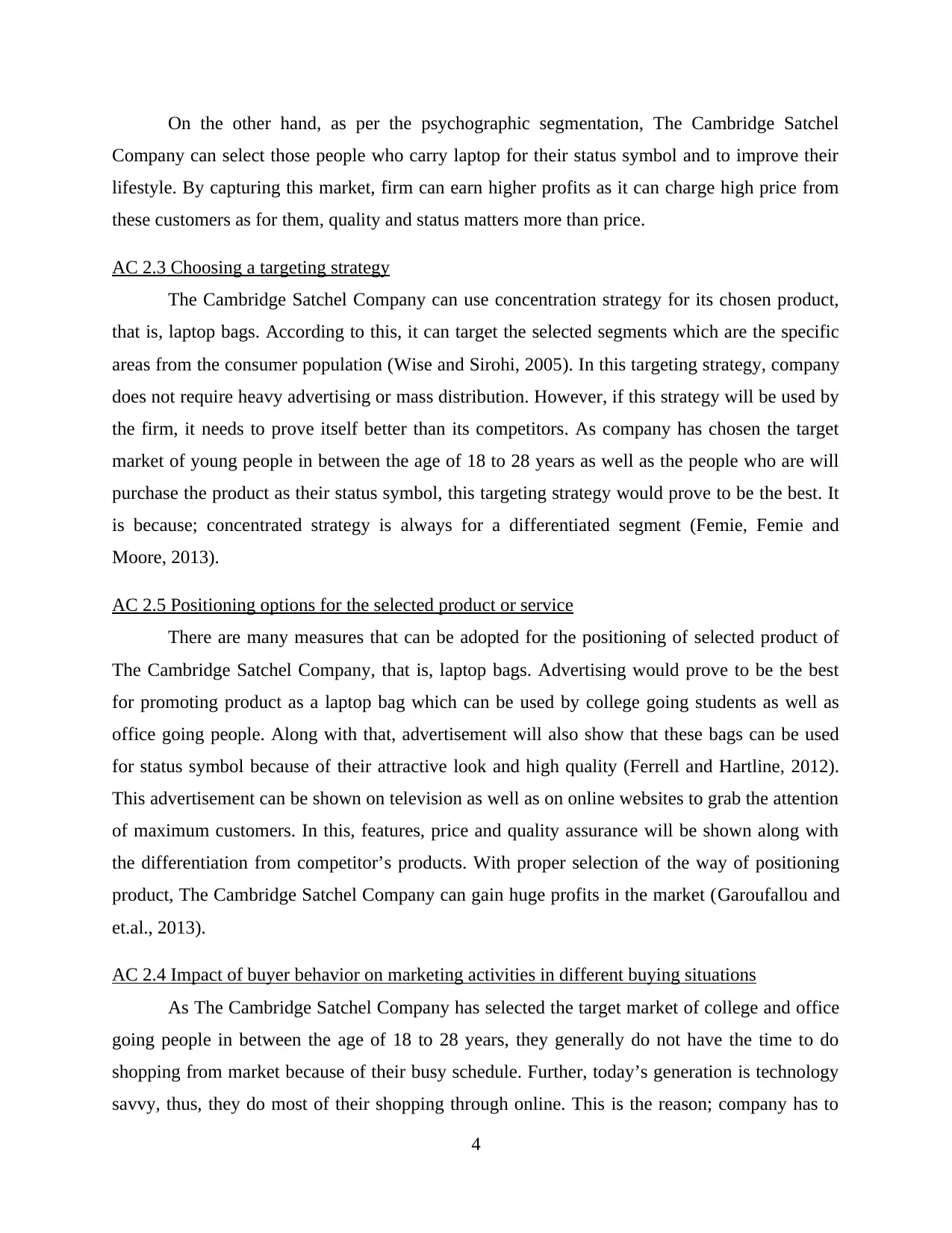
On the other hand, as per the psychographic segmentation, The Cambridge Satchel
Company can select those people who carry laptop for their status symbol and to improve their
lifestyle. By capturing this market, firm can earn higher profits as it can charge high price from
these customers as for them, quality and status matters more than price.
AC 2.3 Choosing a targeting strategy
The Cambridge Satchel Company can use concentration strategy for its chosen product,
that is, laptop bags. According to this, it can target the selected segments which are the specific
areas from the consumer population (Wise and Sirohi, 2005). In this targeting strategy, company
does not require heavy advertising or mass distribution. However, if this strategy will be used by
the firm, it needs to prove itself better than its competitors. As company has chosen the target
market of young people in between the age of 18 to 28 years as well as the people who are will
purchase the product as their status symbol, this targeting strategy would prove to be the best. It
is because; concentrated strategy is always for a differentiated segment (Femie, Femie and
Moore, 2013).
AC 2.5 Positioning options for the selected product or service
There are many measures that can be adopted for the positioning of selected product of
The Cambridge Satchel Company, that is, laptop bags. Advertising would prove to be the best
for promoting product as a laptop bag which can be used by college going students as well as
office going people. Along with that, advertisement will also show that these bags can be used
for status symbol because of their attractive look and high quality (Ferrell and Hartline, 2012).
This advertisement can be shown on television as well as on online websites to grab the attention
of maximum customers. In this, features, price and quality assurance will be shown along with
the differentiation from competitor’s products. With proper selection of the way of positioning
product, The Cambridge Satchel Company can gain huge profits in the market (Garoufallou and
et.al., 2013).
AC 2.4 Impact of buyer behavior on marketing activities in different buying situations
As The Cambridge Satchel Company has selected the target market of college and office
going people in between the age of 18 to 28 years, they generally do not have the time to do
shopping from market because of their busy schedule. Further, today’s generation is technology
savvy, thus, they do most of their shopping through online. This is the reason; company has to
4
Company can select those people who carry laptop for their status symbol and to improve their
lifestyle. By capturing this market, firm can earn higher profits as it can charge high price from
these customers as for them, quality and status matters more than price.
AC 2.3 Choosing a targeting strategy
The Cambridge Satchel Company can use concentration strategy for its chosen product,
that is, laptop bags. According to this, it can target the selected segments which are the specific
areas from the consumer population (Wise and Sirohi, 2005). In this targeting strategy, company
does not require heavy advertising or mass distribution. However, if this strategy will be used by
the firm, it needs to prove itself better than its competitors. As company has chosen the target
market of young people in between the age of 18 to 28 years as well as the people who are will
purchase the product as their status symbol, this targeting strategy would prove to be the best. It
is because; concentrated strategy is always for a differentiated segment (Femie, Femie and
Moore, 2013).
AC 2.5 Positioning options for the selected product or service
There are many measures that can be adopted for the positioning of selected product of
The Cambridge Satchel Company, that is, laptop bags. Advertising would prove to be the best
for promoting product as a laptop bag which can be used by college going students as well as
office going people. Along with that, advertisement will also show that these bags can be used
for status symbol because of their attractive look and high quality (Ferrell and Hartline, 2012).
This advertisement can be shown on television as well as on online websites to grab the attention
of maximum customers. In this, features, price and quality assurance will be shown along with
the differentiation from competitor’s products. With proper selection of the way of positioning
product, The Cambridge Satchel Company can gain huge profits in the market (Garoufallou and
et.al., 2013).
AC 2.4 Impact of buyer behavior on marketing activities in different buying situations
As The Cambridge Satchel Company has selected the target market of college and office
going people in between the age of 18 to 28 years, they generally do not have the time to do
shopping from market because of their busy schedule. Further, today’s generation is technology
savvy, thus, they do most of their shopping through online. This is the reason; company has to
4
⊘ This is a preview!⊘
Do you want full access?
Subscribe today to unlock all pages.

Trusted by 1+ million students worldwide
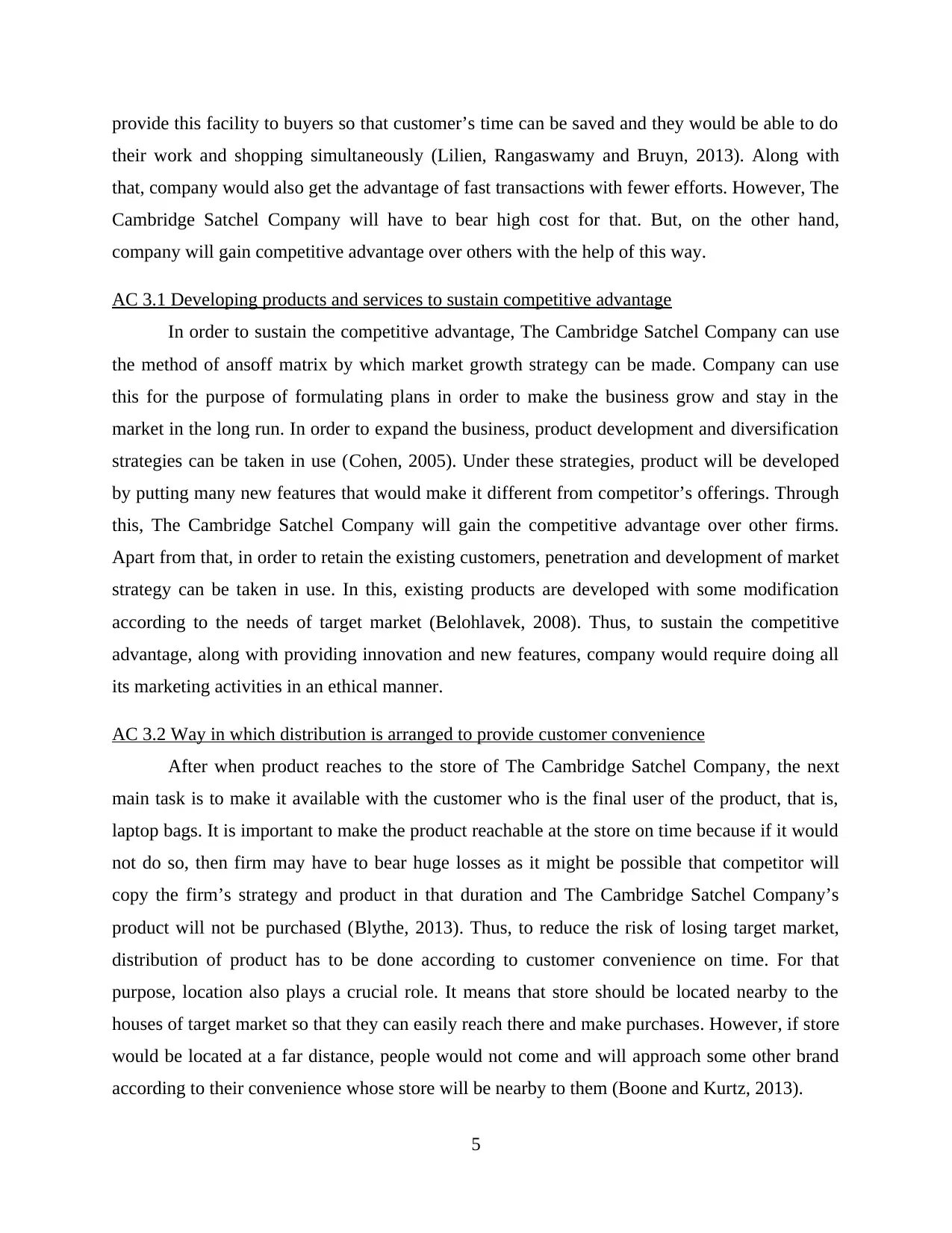
provide this facility to buyers so that customer’s time can be saved and they would be able to do
their work and shopping simultaneously (Lilien, Rangaswamy and Bruyn, 2013). Along with
that, company would also get the advantage of fast transactions with fewer efforts. However, The
Cambridge Satchel Company will have to bear high cost for that. But, on the other hand,
company will gain competitive advantage over others with the help of this way.
AC 3.1 Developing products and services to sustain competitive advantage
In order to sustain the competitive advantage, The Cambridge Satchel Company can use
the method of ansoff matrix by which market growth strategy can be made. Company can use
this for the purpose of formulating plans in order to make the business grow and stay in the
market in the long run. In order to expand the business, product development and diversification
strategies can be taken in use (Cohen, 2005). Under these strategies, product will be developed
by putting many new features that would make it different from competitor’s offerings. Through
this, The Cambridge Satchel Company will gain the competitive advantage over other firms.
Apart from that, in order to retain the existing customers, penetration and development of market
strategy can be taken in use. In this, existing products are developed with some modification
according to the needs of target market (Belohlavek, 2008). Thus, to sustain the competitive
advantage, along with providing innovation and new features, company would require doing all
its marketing activities in an ethical manner.
AC 3.2 Way in which distribution is arranged to provide customer convenience
After when product reaches to the store of The Cambridge Satchel Company, the next
main task is to make it available with the customer who is the final user of the product, that is,
laptop bags. It is important to make the product reachable at the store on time because if it would
not do so, then firm may have to bear huge losses as it might be possible that competitor will
copy the firm’s strategy and product in that duration and The Cambridge Satchel Company’s
product will not be purchased (Blythe, 2013). Thus, to reduce the risk of losing target market,
distribution of product has to be done according to customer convenience on time. For that
purpose, location also plays a crucial role. It means that store should be located nearby to the
houses of target market so that they can easily reach there and make purchases. However, if store
would be located at a far distance, people would not come and will approach some other brand
according to their convenience whose store will be nearby to them (Boone and Kurtz, 2013).
5
their work and shopping simultaneously (Lilien, Rangaswamy and Bruyn, 2013). Along with
that, company would also get the advantage of fast transactions with fewer efforts. However, The
Cambridge Satchel Company will have to bear high cost for that. But, on the other hand,
company will gain competitive advantage over others with the help of this way.
AC 3.1 Developing products and services to sustain competitive advantage
In order to sustain the competitive advantage, The Cambridge Satchel Company can use
the method of ansoff matrix by which market growth strategy can be made. Company can use
this for the purpose of formulating plans in order to make the business grow and stay in the
market in the long run. In order to expand the business, product development and diversification
strategies can be taken in use (Cohen, 2005). Under these strategies, product will be developed
by putting many new features that would make it different from competitor’s offerings. Through
this, The Cambridge Satchel Company will gain the competitive advantage over other firms.
Apart from that, in order to retain the existing customers, penetration and development of market
strategy can be taken in use. In this, existing products are developed with some modification
according to the needs of target market (Belohlavek, 2008). Thus, to sustain the competitive
advantage, along with providing innovation and new features, company would require doing all
its marketing activities in an ethical manner.
AC 3.2 Way in which distribution is arranged to provide customer convenience
After when product reaches to the store of The Cambridge Satchel Company, the next
main task is to make it available with the customer who is the final user of the product, that is,
laptop bags. It is important to make the product reachable at the store on time because if it would
not do so, then firm may have to bear huge losses as it might be possible that competitor will
copy the firm’s strategy and product in that duration and The Cambridge Satchel Company’s
product will not be purchased (Blythe, 2013). Thus, to reduce the risk of losing target market,
distribution of product has to be done according to customer convenience on time. For that
purpose, location also plays a crucial role. It means that store should be located nearby to the
houses of target market so that they can easily reach there and make purchases. However, if store
would be located at a far distance, people would not come and will approach some other brand
according to their convenience whose store will be nearby to them (Boone and Kurtz, 2013).
5
Paraphrase This Document
Need a fresh take? Get an instant paraphrase of this document with our AI Paraphraser
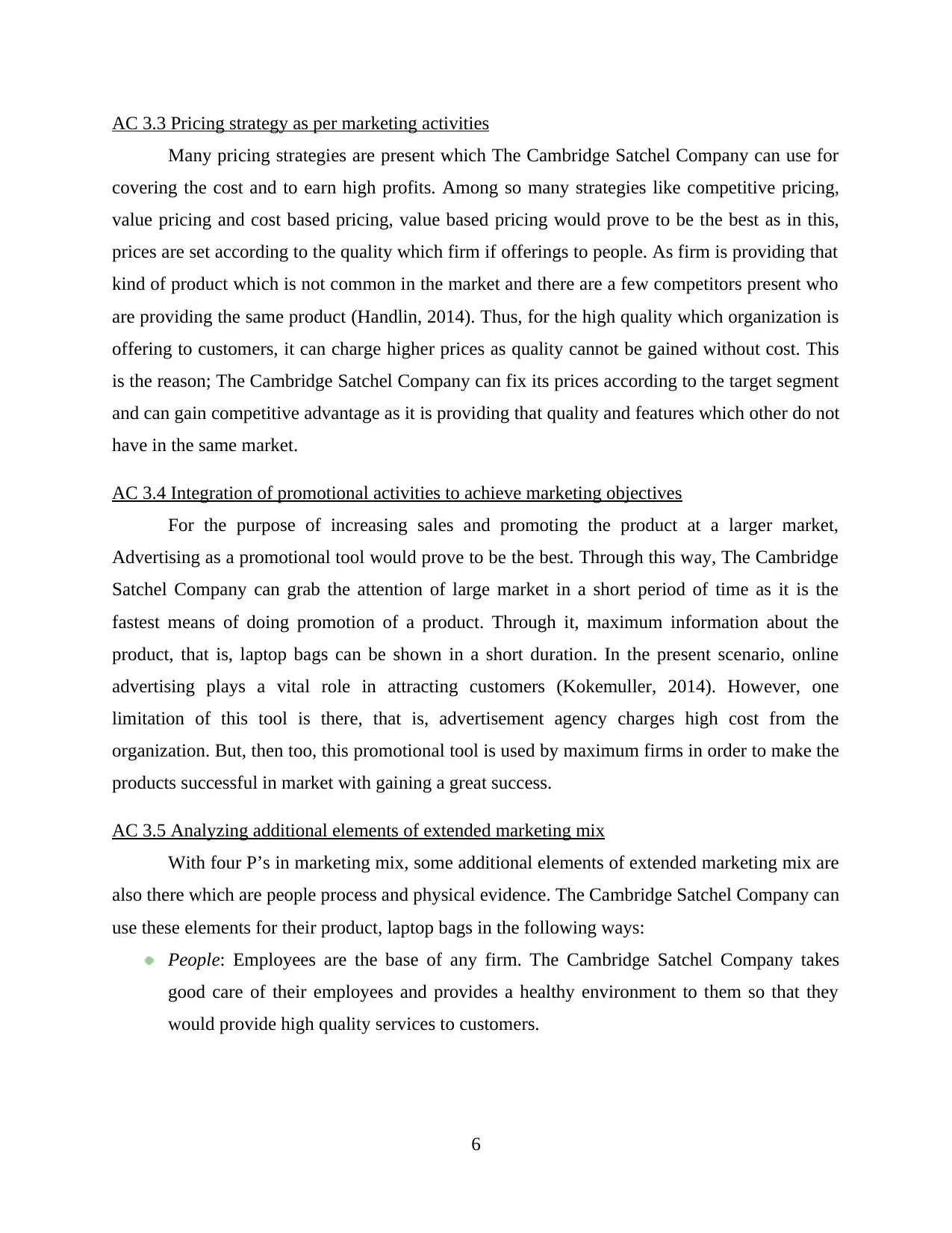
AC 3.3 Pricing strategy as per marketing activities
Many pricing strategies are present which The Cambridge Satchel Company can use for
covering the cost and to earn high profits. Among so many strategies like competitive pricing,
value pricing and cost based pricing, value based pricing would prove to be the best as in this,
prices are set according to the quality which firm if offerings to people. As firm is providing that
kind of product which is not common in the market and there are a few competitors present who
are providing the same product (Handlin, 2014). Thus, for the high quality which organization is
offering to customers, it can charge higher prices as quality cannot be gained without cost. This
is the reason; The Cambridge Satchel Company can fix its prices according to the target segment
and can gain competitive advantage as it is providing that quality and features which other do not
have in the same market.
AC 3.4 Integration of promotional activities to achieve marketing objectives
For the purpose of increasing sales and promoting the product at a larger market,
Advertising as a promotional tool would prove to be the best. Through this way, The Cambridge
Satchel Company can grab the attention of large market in a short period of time as it is the
fastest means of doing promotion of a product. Through it, maximum information about the
product, that is, laptop bags can be shown in a short duration. In the present scenario, online
advertising plays a vital role in attracting customers (Kokemuller, 2014). However, one
limitation of this tool is there, that is, advertisement agency charges high cost from the
organization. But, then too, this promotional tool is used by maximum firms in order to make the
products successful in market with gaining a great success.
AC 3.5 Analyzing additional elements of extended marketing mix
With four P’s in marketing mix, some additional elements of extended marketing mix are
also there which are people process and physical evidence. The Cambridge Satchel Company can
use these elements for their product, laptop bags in the following ways:
People: Employees are the base of any firm. The Cambridge Satchel Company takes
good care of their employees and provides a healthy environment to them so that they
would provide high quality services to customers.
6
Many pricing strategies are present which The Cambridge Satchel Company can use for
covering the cost and to earn high profits. Among so many strategies like competitive pricing,
value pricing and cost based pricing, value based pricing would prove to be the best as in this,
prices are set according to the quality which firm if offerings to people. As firm is providing that
kind of product which is not common in the market and there are a few competitors present who
are providing the same product (Handlin, 2014). Thus, for the high quality which organization is
offering to customers, it can charge higher prices as quality cannot be gained without cost. This
is the reason; The Cambridge Satchel Company can fix its prices according to the target segment
and can gain competitive advantage as it is providing that quality and features which other do not
have in the same market.
AC 3.4 Integration of promotional activities to achieve marketing objectives
For the purpose of increasing sales and promoting the product at a larger market,
Advertising as a promotional tool would prove to be the best. Through this way, The Cambridge
Satchel Company can grab the attention of large market in a short period of time as it is the
fastest means of doing promotion of a product. Through it, maximum information about the
product, that is, laptop bags can be shown in a short duration. In the present scenario, online
advertising plays a vital role in attracting customers (Kokemuller, 2014). However, one
limitation of this tool is there, that is, advertisement agency charges high cost from the
organization. But, then too, this promotional tool is used by maximum firms in order to make the
products successful in market with gaining a great success.
AC 3.5 Analyzing additional elements of extended marketing mix
With four P’s in marketing mix, some additional elements of extended marketing mix are
also there which are people process and physical evidence. The Cambridge Satchel Company can
use these elements for their product, laptop bags in the following ways:
People: Employees are the base of any firm. The Cambridge Satchel Company takes
good care of their employees and provides a healthy environment to them so that they
would provide high quality services to customers.
6
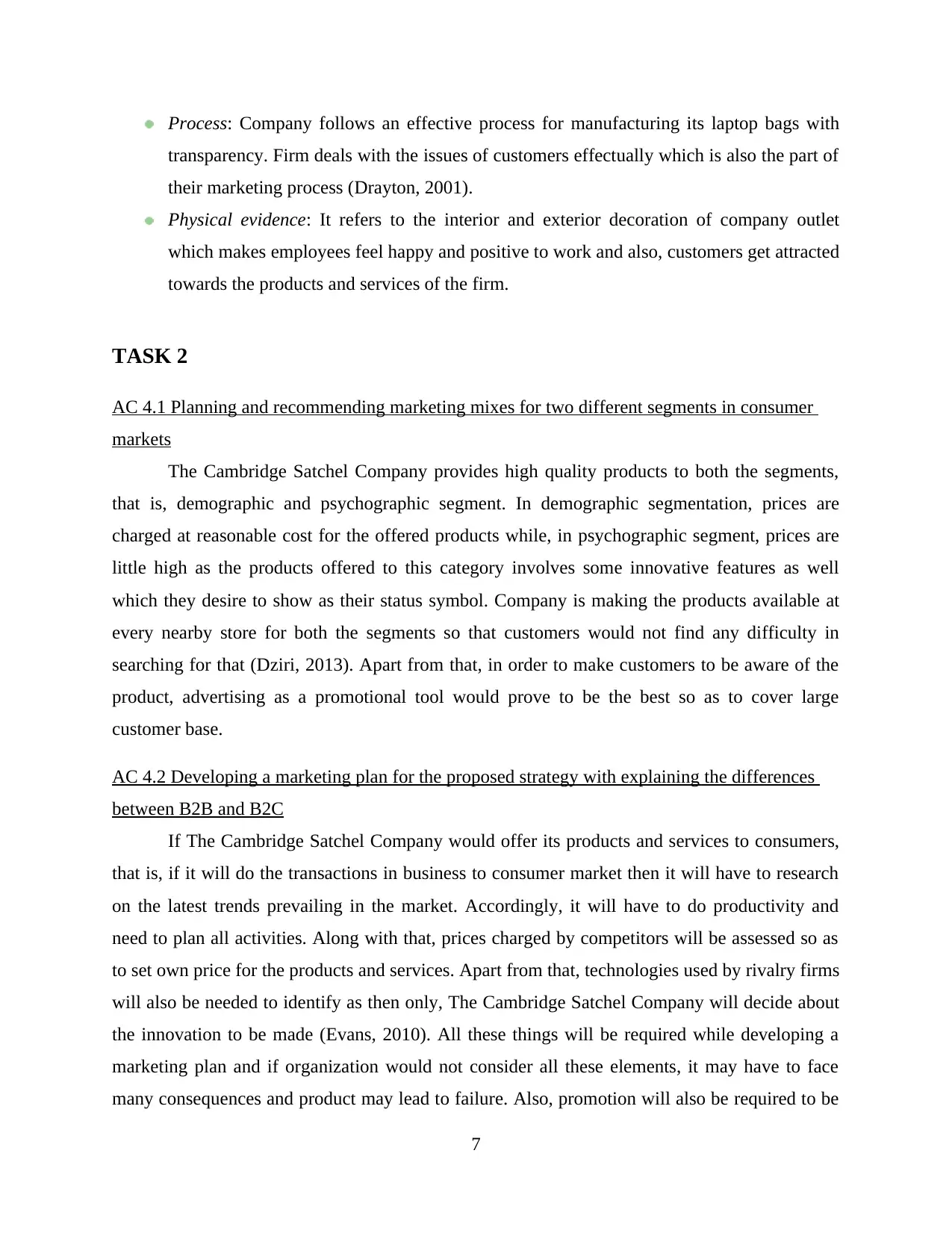
Process: Company follows an effective process for manufacturing its laptop bags with
transparency. Firm deals with the issues of customers effectually which is also the part of
their marketing process (Drayton, 2001).
Physical evidence: It refers to the interior and exterior decoration of company outlet
which makes employees feel happy and positive to work and also, customers get attracted
towards the products and services of the firm.
TASK 2
AC 4.1 Planning and recommending marketing mixes for two different segments in consumer
markets
The Cambridge Satchel Company provides high quality products to both the segments,
that is, demographic and psychographic segment. In demographic segmentation, prices are
charged at reasonable cost for the offered products while, in psychographic segment, prices are
little high as the products offered to this category involves some innovative features as well
which they desire to show as their status symbol. Company is making the products available at
every nearby store for both the segments so that customers would not find any difficulty in
searching for that (Dziri, 2013). Apart from that, in order to make customers to be aware of the
product, advertising as a promotional tool would prove to be the best so as to cover large
customer base.
AC 4.2 Developing a marketing plan for the proposed strategy with explaining the differences
between B2B and B2C
If The Cambridge Satchel Company would offer its products and services to consumers,
that is, if it will do the transactions in business to consumer market then it will have to research
on the latest trends prevailing in the market. Accordingly, it will have to do productivity and
need to plan all activities. Along with that, prices charged by competitors will be assessed so as
to set own price for the products and services. Apart from that, technologies used by rivalry firms
will also be needed to identify as then only, The Cambridge Satchel Company will decide about
the innovation to be made (Evans, 2010). All these things will be required while developing a
marketing plan and if organization would not consider all these elements, it may have to face
many consequences and product may lead to failure. Also, promotion will also be required to be
7
transparency. Firm deals with the issues of customers effectually which is also the part of
their marketing process (Drayton, 2001).
Physical evidence: It refers to the interior and exterior decoration of company outlet
which makes employees feel happy and positive to work and also, customers get attracted
towards the products and services of the firm.
TASK 2
AC 4.1 Planning and recommending marketing mixes for two different segments in consumer
markets
The Cambridge Satchel Company provides high quality products to both the segments,
that is, demographic and psychographic segment. In demographic segmentation, prices are
charged at reasonable cost for the offered products while, in psychographic segment, prices are
little high as the products offered to this category involves some innovative features as well
which they desire to show as their status symbol. Company is making the products available at
every nearby store for both the segments so that customers would not find any difficulty in
searching for that (Dziri, 2013). Apart from that, in order to make customers to be aware of the
product, advertising as a promotional tool would prove to be the best so as to cover large
customer base.
AC 4.2 Developing a marketing plan for the proposed strategy with explaining the differences
between B2B and B2C
If The Cambridge Satchel Company would offer its products and services to consumers,
that is, if it will do the transactions in business to consumer market then it will have to research
on the latest trends prevailing in the market. Accordingly, it will have to do productivity and
need to plan all activities. Along with that, prices charged by competitors will be assessed so as
to set own price for the products and services. Apart from that, technologies used by rivalry firms
will also be needed to identify as then only, The Cambridge Satchel Company will decide about
the innovation to be made (Evans, 2010). All these things will be required while developing a
marketing plan and if organization would not consider all these elements, it may have to face
many consequences and product may lead to failure. Also, promotion will also be required to be
7
⊘ This is a preview!⊘
Do you want full access?
Subscribe today to unlock all pages.

Trusted by 1+ million students worldwide
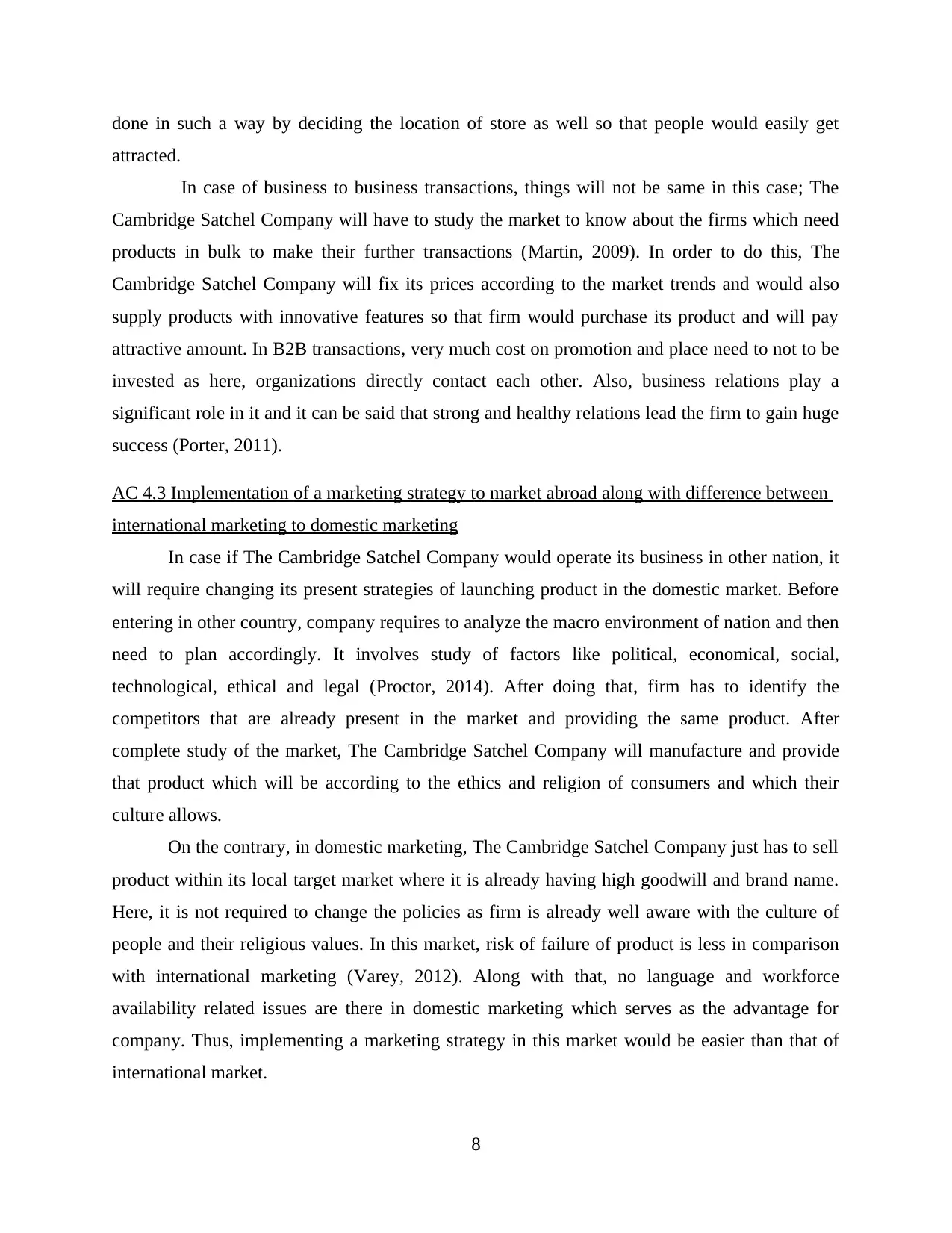
done in such a way by deciding the location of store as well so that people would easily get
attracted.
In case of business to business transactions, things will not be same in this case; The
Cambridge Satchel Company will have to study the market to know about the firms which need
products in bulk to make their further transactions (Martin, 2009). In order to do this, The
Cambridge Satchel Company will fix its prices according to the market trends and would also
supply products with innovative features so that firm would purchase its product and will pay
attractive amount. In B2B transactions, very much cost on promotion and place need to not to be
invested as here, organizations directly contact each other. Also, business relations play a
significant role in it and it can be said that strong and healthy relations lead the firm to gain huge
success (Porter, 2011).
AC 4.3 Implementation of a marketing strategy to market abroad along with difference between
international marketing to domestic marketing
In case if The Cambridge Satchel Company would operate its business in other nation, it
will require changing its present strategies of launching product in the domestic market. Before
entering in other country, company requires to analyze the macro environment of nation and then
need to plan accordingly. It involves study of factors like political, economical, social,
technological, ethical and legal (Proctor, 2014). After doing that, firm has to identify the
competitors that are already present in the market and providing the same product. After
complete study of the market, The Cambridge Satchel Company will manufacture and provide
that product which will be according to the ethics and religion of consumers and which their
culture allows.
On the contrary, in domestic marketing, The Cambridge Satchel Company just has to sell
product within its local target market where it is already having high goodwill and brand name.
Here, it is not required to change the policies as firm is already well aware with the culture of
people and their religious values. In this market, risk of failure of product is less in comparison
with international marketing (Varey, 2012). Along with that, no language and workforce
availability related issues are there in domestic marketing which serves as the advantage for
company. Thus, implementing a marketing strategy in this market would be easier than that of
international market.
8
attracted.
In case of business to business transactions, things will not be same in this case; The
Cambridge Satchel Company will have to study the market to know about the firms which need
products in bulk to make their further transactions (Martin, 2009). In order to do this, The
Cambridge Satchel Company will fix its prices according to the market trends and would also
supply products with innovative features so that firm would purchase its product and will pay
attractive amount. In B2B transactions, very much cost on promotion and place need to not to be
invested as here, organizations directly contact each other. Also, business relations play a
significant role in it and it can be said that strong and healthy relations lead the firm to gain huge
success (Porter, 2011).
AC 4.3 Implementation of a marketing strategy to market abroad along with difference between
international marketing to domestic marketing
In case if The Cambridge Satchel Company would operate its business in other nation, it
will require changing its present strategies of launching product in the domestic market. Before
entering in other country, company requires to analyze the macro environment of nation and then
need to plan accordingly. It involves study of factors like political, economical, social,
technological, ethical and legal (Proctor, 2014). After doing that, firm has to identify the
competitors that are already present in the market and providing the same product. After
complete study of the market, The Cambridge Satchel Company will manufacture and provide
that product which will be according to the ethics and religion of consumers and which their
culture allows.
On the contrary, in domestic marketing, The Cambridge Satchel Company just has to sell
product within its local target market where it is already having high goodwill and brand name.
Here, it is not required to change the policies as firm is already well aware with the culture of
people and their religious values. In this market, risk of failure of product is less in comparison
with international marketing (Varey, 2012). Along with that, no language and workforce
availability related issues are there in domestic marketing which serves as the advantage for
company. Thus, implementing a marketing strategy in this market would be easier than that of
international market.
8
Paraphrase This Document
Need a fresh take? Get an instant paraphrase of this document with our AI Paraphraser
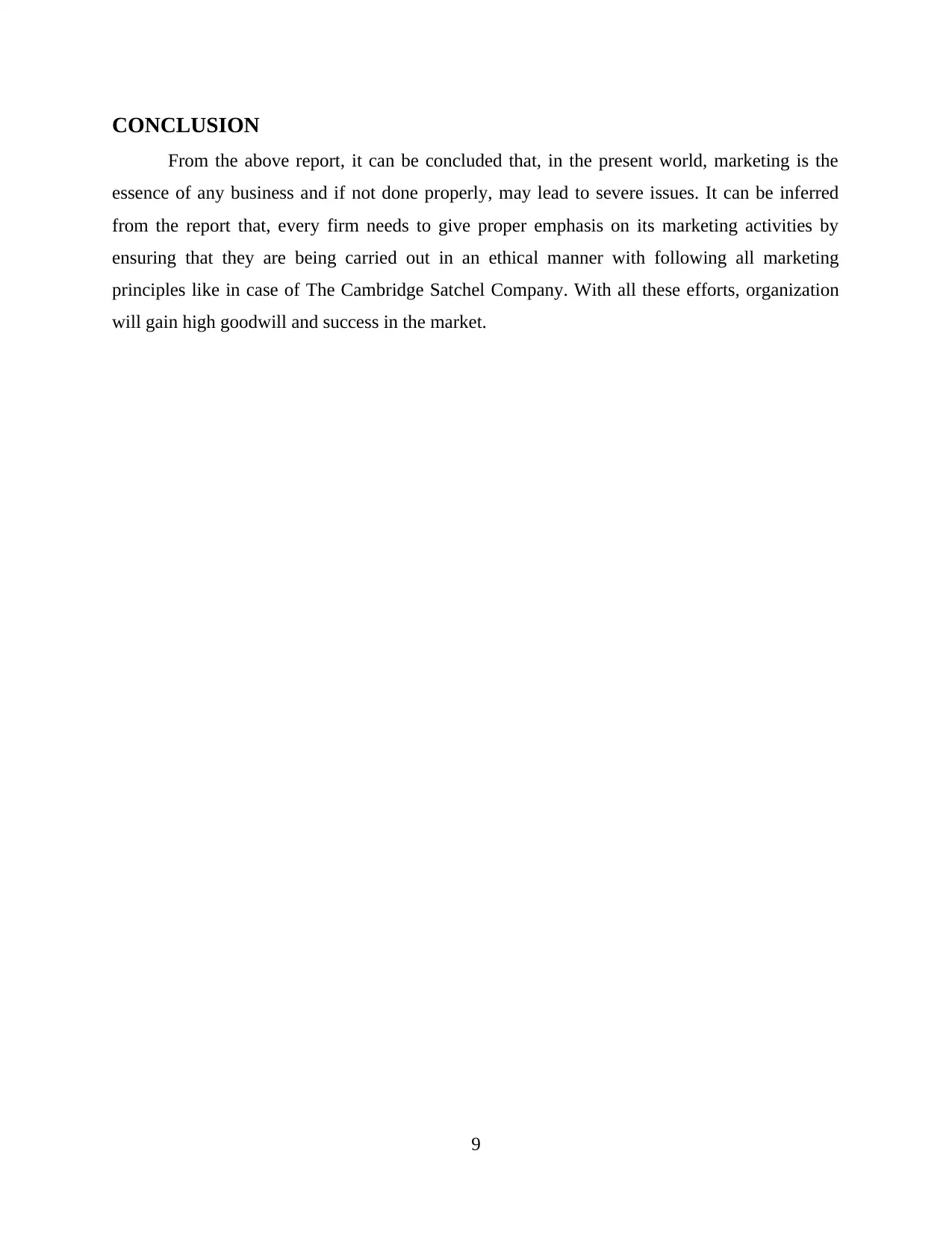
CONCLUSION
From the above report, it can be concluded that, in the present world, marketing is the
essence of any business and if not done properly, may lead to severe issues. It can be inferred
from the report that, every firm needs to give proper emphasis on its marketing activities by
ensuring that they are being carried out in an ethical manner with following all marketing
principles like in case of The Cambridge Satchel Company. With all these efforts, organization
will gain high goodwill and success in the market.
9
From the above report, it can be concluded that, in the present world, marketing is the
essence of any business and if not done properly, may lead to severe issues. It can be inferred
from the report that, every firm needs to give proper emphasis on its marketing activities by
ensuring that they are being carried out in an ethical manner with following all marketing
principles like in case of The Cambridge Satchel Company. With all these efforts, organization
will gain high goodwill and success in the market.
9
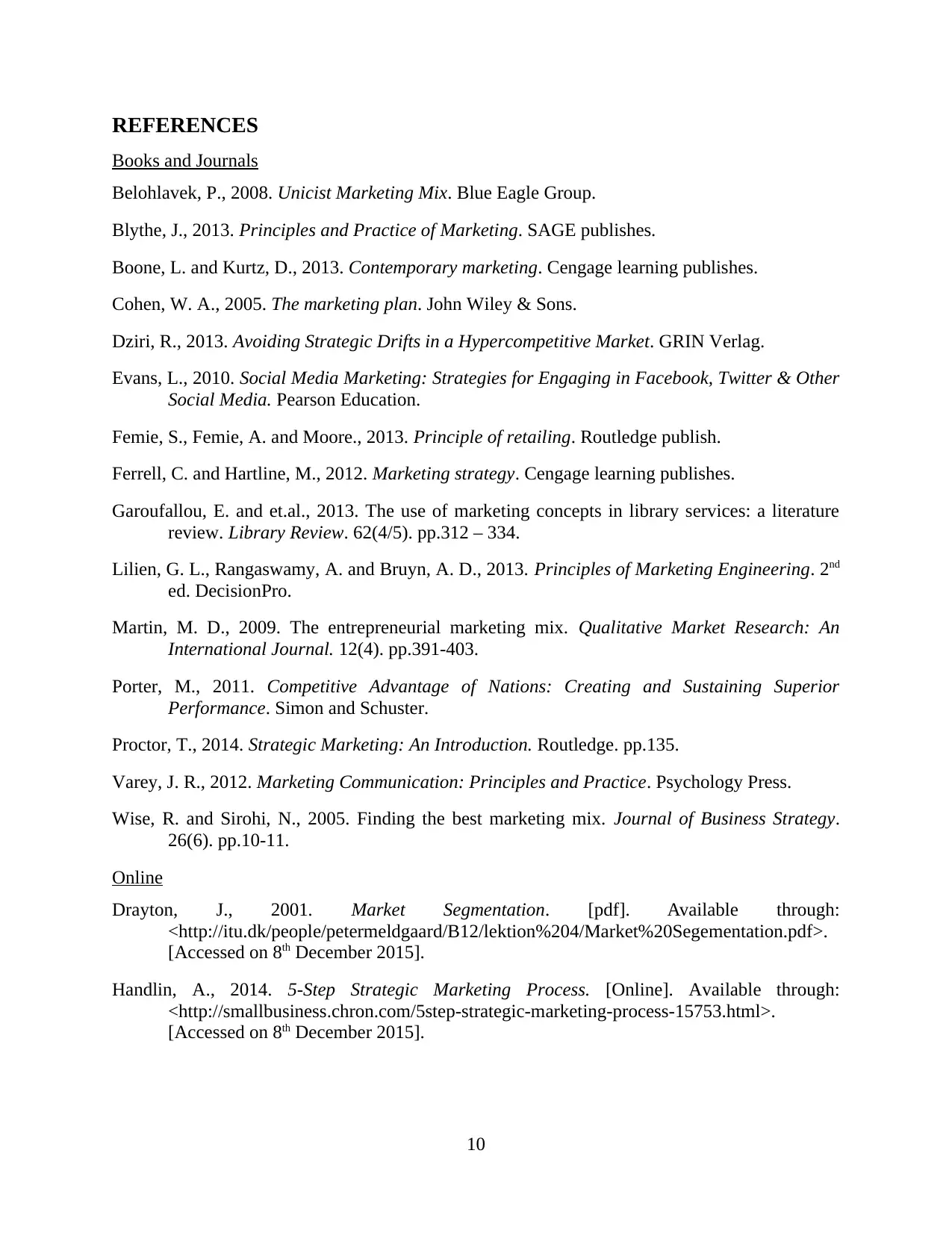
REFERENCES
Books and Journals
Belohlavek, P., 2008. Unicist Marketing Mix. Blue Eagle Group.
Blythe, J., 2013. Principles and Practice of Marketing. SAGE publishes.
Boone, L. and Kurtz, D., 2013. Contemporary marketing. Cengage learning publishes.
Cohen, W. A., 2005. The marketing plan. John Wiley & Sons.
Dziri, R., 2013. Avoiding Strategic Drifts in a Hypercompetitive Market. GRIN Verlag.
Evans, L., 2010. Social Media Marketing: Strategies for Engaging in Facebook, Twitter & Other
Social Media. Pearson Education.
Femie, S., Femie, A. and Moore., 2013. Principle of retailing. Routledge publish.
Ferrell, C. and Hartline, M., 2012. Marketing strategy. Cengage learning publishes.
Garoufallou, E. and et.al., 2013. The use of marketing concepts in library services: a literature
review. Library Review. 62(4/5). pp.312 – 334.
Lilien, G. L., Rangaswamy, A. and Bruyn, A. D., 2013. Principles of Marketing Engineering. 2nd
ed. DecisionPro.
Martin, M. D., 2009. The entrepreneurial marketing mix. Qualitative Market Research: An
International Journal. 12(4). pp.391-403.
Porter, M., 2011. Competitive Advantage of Nations: Creating and Sustaining Superior
Performance. Simon and Schuster.
Proctor, T., 2014. Strategic Marketing: An Introduction. Routledge. pp.135.
Varey, J. R., 2012. Marketing Communication: Principles and Practice. Psychology Press.
Wise, R. and Sirohi, N., 2005. Finding the best marketing mix. Journal of Business Strategy.
26(6). pp.10-11.
Online
Drayton, J., 2001. Market Segmentation. [pdf]. Available through:
<http://itu.dk/people/petermeldgaard/B12/lektion%204/Market%20Segementation.pdf>.
[Accessed on 8th December 2015].
Handlin, A., 2014. 5-Step Strategic Marketing Process. [Online]. Available through:
<http://smallbusiness.chron.com/5step-strategic-marketing-process-15753.html>.
[Accessed on 8th December 2015].
10
Books and Journals
Belohlavek, P., 2008. Unicist Marketing Mix. Blue Eagle Group.
Blythe, J., 2013. Principles and Practice of Marketing. SAGE publishes.
Boone, L. and Kurtz, D., 2013. Contemporary marketing. Cengage learning publishes.
Cohen, W. A., 2005. The marketing plan. John Wiley & Sons.
Dziri, R., 2013. Avoiding Strategic Drifts in a Hypercompetitive Market. GRIN Verlag.
Evans, L., 2010. Social Media Marketing: Strategies for Engaging in Facebook, Twitter & Other
Social Media. Pearson Education.
Femie, S., Femie, A. and Moore., 2013. Principle of retailing. Routledge publish.
Ferrell, C. and Hartline, M., 2012. Marketing strategy. Cengage learning publishes.
Garoufallou, E. and et.al., 2013. The use of marketing concepts in library services: a literature
review. Library Review. 62(4/5). pp.312 – 334.
Lilien, G. L., Rangaswamy, A. and Bruyn, A. D., 2013. Principles of Marketing Engineering. 2nd
ed. DecisionPro.
Martin, M. D., 2009. The entrepreneurial marketing mix. Qualitative Market Research: An
International Journal. 12(4). pp.391-403.
Porter, M., 2011. Competitive Advantage of Nations: Creating and Sustaining Superior
Performance. Simon and Schuster.
Proctor, T., 2014. Strategic Marketing: An Introduction. Routledge. pp.135.
Varey, J. R., 2012. Marketing Communication: Principles and Practice. Psychology Press.
Wise, R. and Sirohi, N., 2005. Finding the best marketing mix. Journal of Business Strategy.
26(6). pp.10-11.
Online
Drayton, J., 2001. Market Segmentation. [pdf]. Available through:
<http://itu.dk/people/petermeldgaard/B12/lektion%204/Market%20Segementation.pdf>.
[Accessed on 8th December 2015].
Handlin, A., 2014. 5-Step Strategic Marketing Process. [Online]. Available through:
<http://smallbusiness.chron.com/5step-strategic-marketing-process-15753.html>.
[Accessed on 8th December 2015].
10
⊘ This is a preview!⊘
Do you want full access?
Subscribe today to unlock all pages.

Trusted by 1+ million students worldwide
1 out of 13
Related Documents
Your All-in-One AI-Powered Toolkit for Academic Success.
+13062052269
info@desklib.com
Available 24*7 on WhatsApp / Email
![[object Object]](/_next/static/media/star-bottom.7253800d.svg)
Unlock your academic potential
Copyright © 2020–2025 A2Z Services. All Rights Reserved. Developed and managed by ZUCOL.





